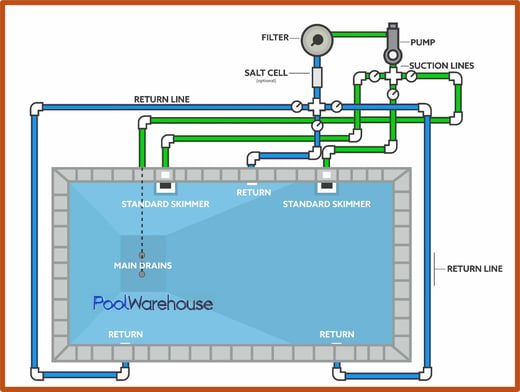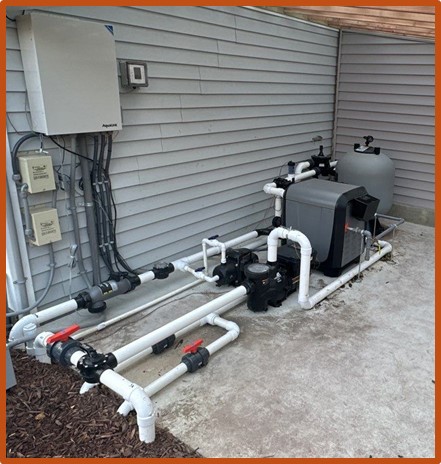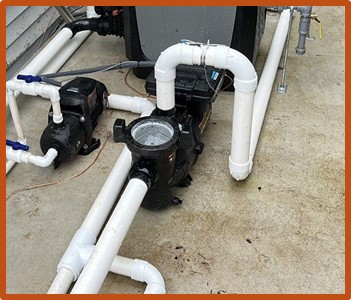Happy Monday! Welcome to the first entry in our new series where we will explore the different aspects and features of a standard inground pool system. Today we will cover the basics of how a system and it's parts all work together to circulate your pool water.
Below is an image borrowed from Pool Warehouse, and it does a great job of showing a birds’ eye view of how a pool system works. Essentially, water leaves the pool body via the skimmers, travels through the suction lines, through the pump, through the filter, then through the heater (not pictured), and from the heater the water is run through the sanitizer (or salt cell) and back into the pool body through the return inlets via the return lines. Now, if you were actually to fly over a pool, you wouldn't see the suction or return lines because they are underground from where they connect to the pool to just before they connect to the rest of the equipment (the pump, filter, etc.). It seems obvious, but you would be surprised how many people don’t realize this before their pool contractor shows up and starts trenching for their pipe-lines.

Now this photo is from one of Denscot’s more recent builds, and it is a good example of a typical system for an inground-Gunite saltwater pool. You can see where the pipes appear to pop up out of the mulch before being redirected by a three-way valve towards the pump and the rest of the system.

The pump is famously and endearingly nick-named the “heart” of the pool’s system. It literally circulates all the pool’s water just as our hearts circulate our blood, pulling the pool water in one end and pushing it out the other.
A number of years back, the use of single speed pumps on swimming pools became illegal, and they are no longer available for purchase or installation through legitimate pool companies. All the pumps Denscot installs are variable speed, ranging from 1 horsepower to 3 or more. Most of our pumps are around 1.85-2.7HP. We work primarily with Jandy and Pentair equipment. Hayward is another common brand, and we see a lot of Hayward pumps through our retail store.
Regardless of brand, size, horsepower, and function (ie: super, stealth, standard, etc), more centrifugal pumps consist of the same basic structure. The wet end contains the input, strainer pot and basket, diffuser, impeller, and discharge port. Water is drawn through the taller, thicker end and gets passed through the strainer pot, or pump basket. You can see this basket through the clear pump lid (see picture below), and many homeowners mistake this for the pool filter. It is, as mentioned before, the first line of defense. This basket will catch the bigger debris that slipped past the skimmer backet way back at the pool wall. It is a good practice to clean this basket out regularly, as the buildup of debris can diminish pump power and effectiveness (much like hardened arteries cause your heart to have to work harder and wear out faster).

The second half of the pump, typically smaller and heavier than the wet end, is the motor itself, which connects via the motor shaft to the impeller. Water is drawn in by the impeller and then thrown out into the volute, or diffuser, which pushes the water out of the pump again through the discharge port at the top of the pump, and into the pipes which lead to the rest of the system.
Unfortunately, not all pump parts are made equal, and putting the wrong part into a pump can have a negative effect on your pump’s performance, or even cause irreparable damage to your pump. If you are a do-it-yourself kind of person, and you swing by your local pool store to pick up a new pump motor seal, seal plate, o-ring, or any of the other little bits and pieces that keep a pump together and functioning, it will make a world of difference to your store associate if you can identify the brand and model. With that information, we can identify the exact model-specific part you need.